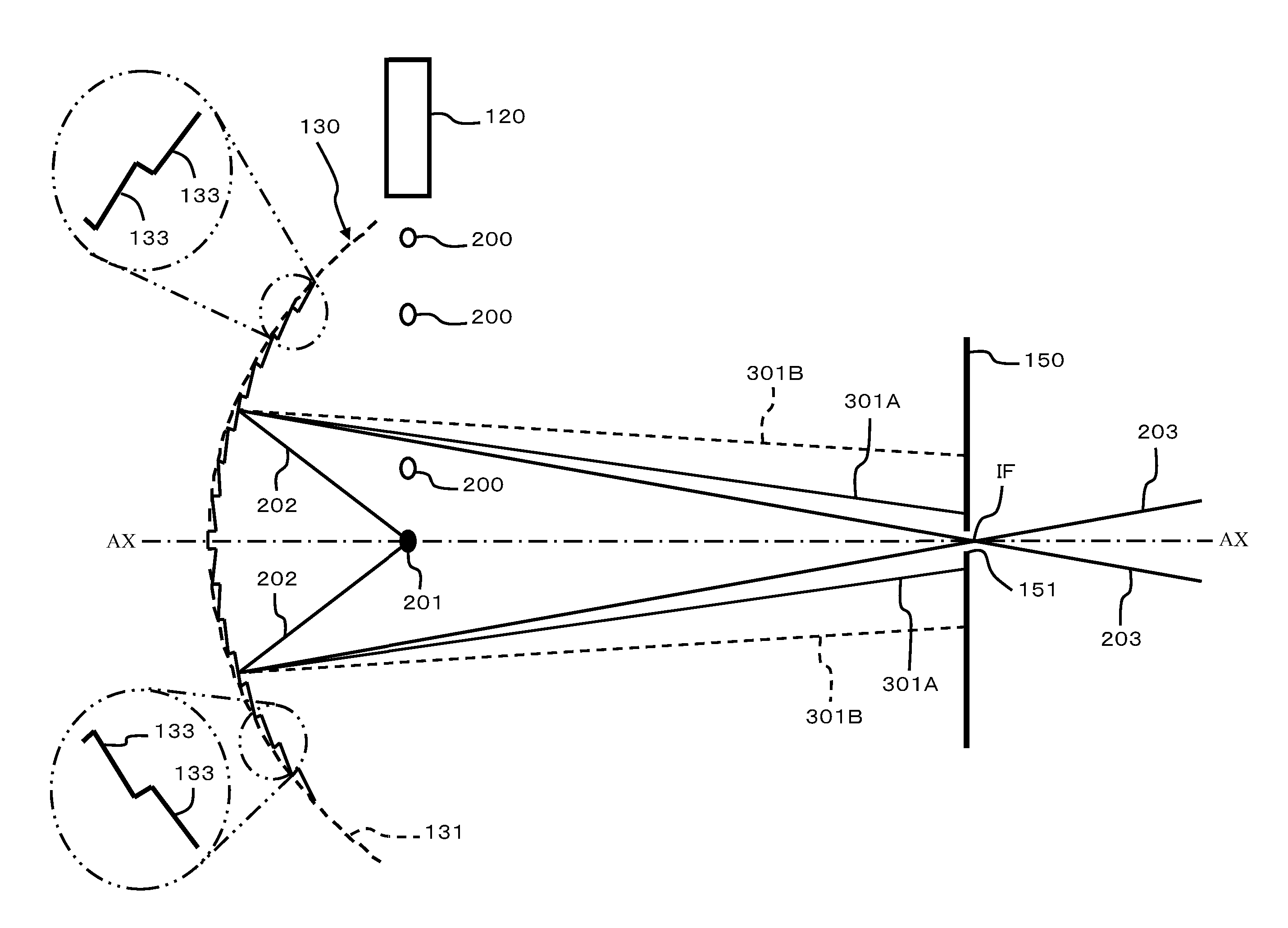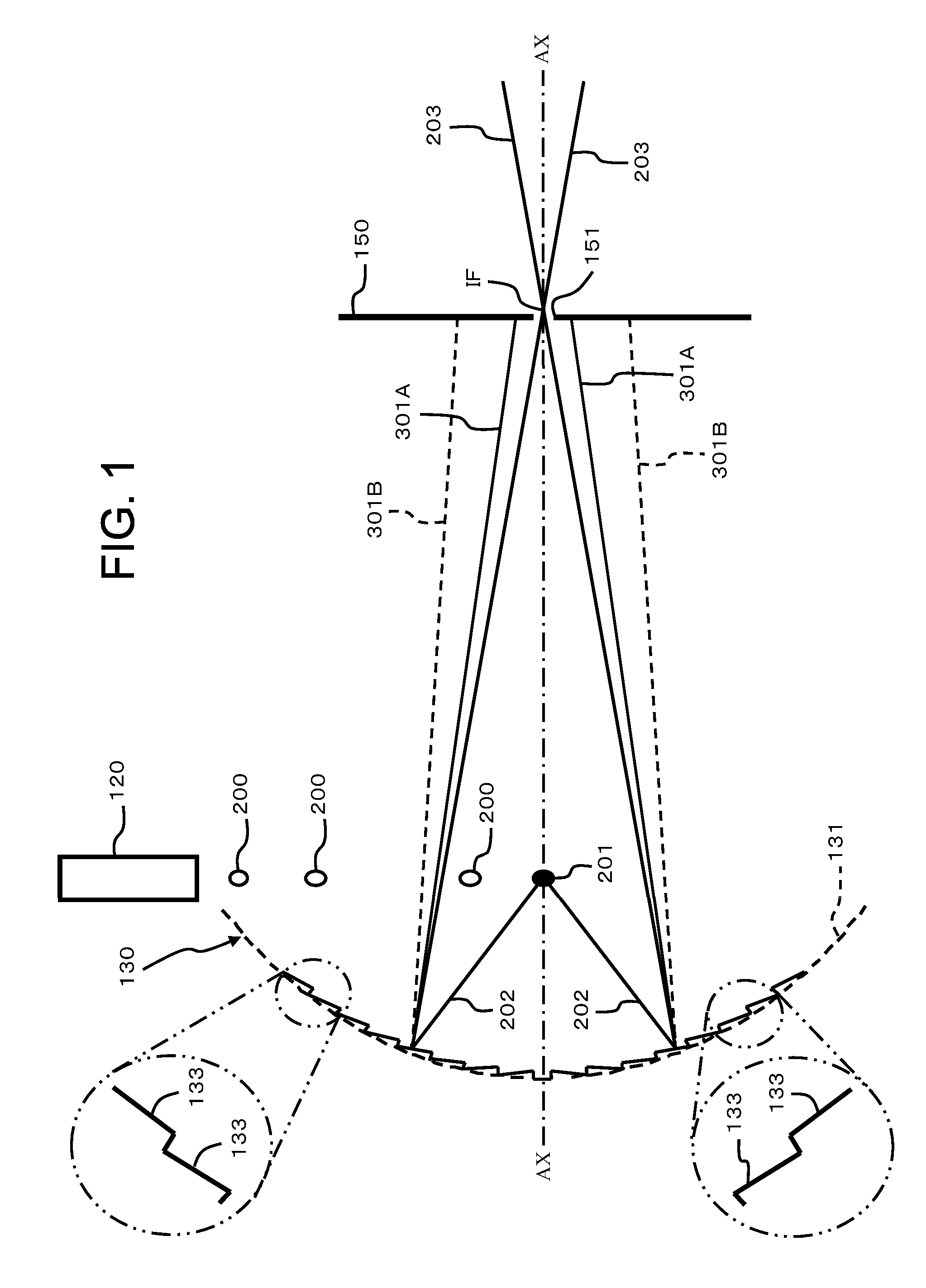Mirror for extreme ultra violet, manufacturing method for mirror for extreme ultra violet, and far ultraviolet light source device
a manufacturing method and ultra violet technology, applied in the direction of optical radiation measurement, electromagnetic radiation sensing, spectrometry/spectrophotometry/monochromator, etc., can solve the problems of heat melting, thin layer type spf can easily be damaged, and the efficiency and reliability of a thin layer type spf are difficult to achiev
- Summary
- Abstract
- Description
- Claims
- Application Information
AI Technical Summary
Benefits of technology
Problems solved by technology
Method used
Image
Examples
embodiment 1
[0059]A first embodiment will now be explained on the basis of FIGS. 1 through 4. FIG. 1 is an explanatory figure showing a magnified view of an EUV collector mirror according to this first embodiment; FIG. 2 is an explanatory figure showing an EUV light source device which incorporates this EUV collector mirror 130; FIG. 3 is an explanatory sectional view showing a magnified view of blazed grooves of this EUV collector mirror 130; and FIG. 4 is a characteristic figure for the setting of Mo / Si pair layer thickness according to the angle of incidence of EUV radiation. First the structure of the EUV light source device 1 will be explained with reference to FIG. 2, and then the structure of the EUV collector mirror 130 will be explained with reference to FIG. 1 etc.
[0060]The EUV light source device 1 shown in FIG. 2 comprises, for example, a vacuum chamber 100, a driver laser light source 110, a target supply device 120, the EUV collector mirror 130, coils for magnetic field generation...
embodiment 2
[0124]A second embodiment of the present invention will now be explained on the basis of FIGS. 5 through 7. The second and third embodiments of the present invention which are described below correspond to variants of the first embodiment described above. Accordingly, the explanation thereof will focus upon the aspects in which these embodiments differ from the first embodiment. The aspects of difference between this second embodiment and the first embodiment are that the blazed grooves are angled in the opposite direction, and that, along with this difference, a dumper 105 is additionally provided.
[0125]FIG. 5 is an explanatory figure showing the EUV light source device 1A according to this second embodiment. A dumper 105 which is provided at a certain position upon the optical axis AX (refer to FIG. 6) absorbs the regularly reflected radiation 301A which has been deflected by the blazed grooves 133 and converts it to thermal energy. It may also be arranged for this dumper 105 to s...
embodiment 3
[0133]A third embodiment of the present invention will now be explained on the basis of FIGS. 8 and 9. In this third embodiment, the blazed grooves are formed in a somewhat different manner. FIG. 8 is a figure showing the EUV collector mirror 130 as seen from the front. The blazed grooves 133 may be formed as concentric circles, as shown in FIG. 8(a), or may be formed as parallel straight lines, as shown in FIG. 8(b).
[0134]If the blazed grooves 133 are formed as parallel straight lines as shown in FIG. 8(b), then it would also be possible, as shown in FIG. 9, to form the blazed grooves to extend in the same direction across the entire surface of the EUV collector mirror 130. Thus, with this third embodiment having the above structure, it is possible to obtain similar beneficial effects to those obtained in the case of the first embodiment.
PUM
 Login to View More
Login to View More Abstract
Description
Claims
Application Information
 Login to View More
Login to View More - R&D
- Intellectual Property
- Life Sciences
- Materials
- Tech Scout
- Unparalleled Data Quality
- Higher Quality Content
- 60% Fewer Hallucinations
Browse by: Latest US Patents, China's latest patents, Technical Efficacy Thesaurus, Application Domain, Technology Topic, Popular Technical Reports.
© 2025 PatSnap. All rights reserved.Legal|Privacy policy|Modern Slavery Act Transparency Statement|Sitemap|About US| Contact US: help@patsnap.com



